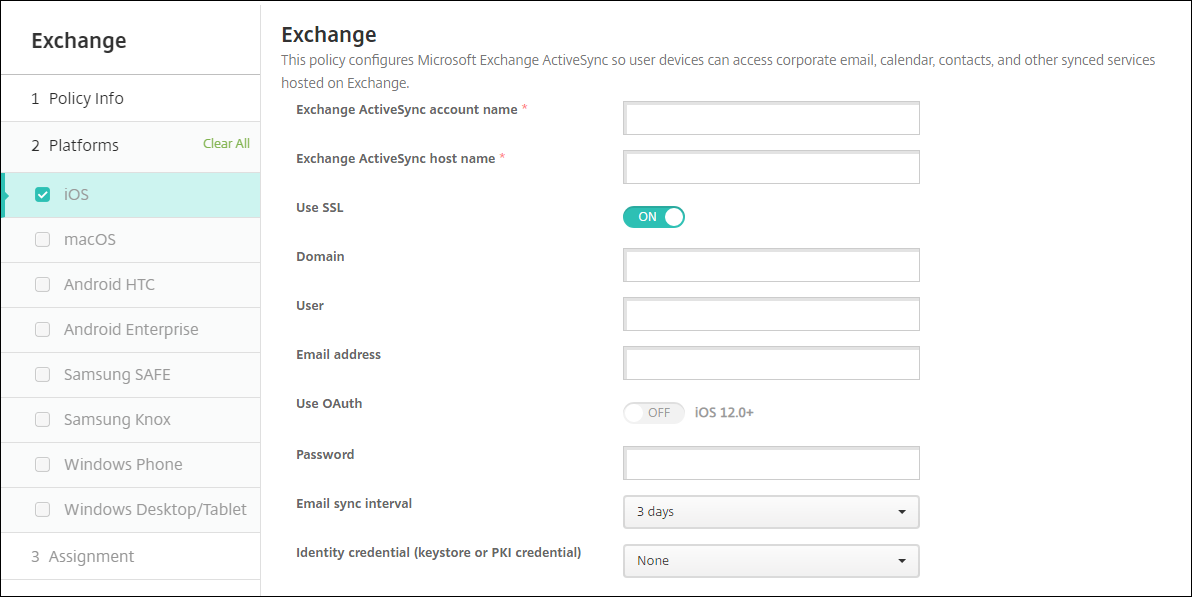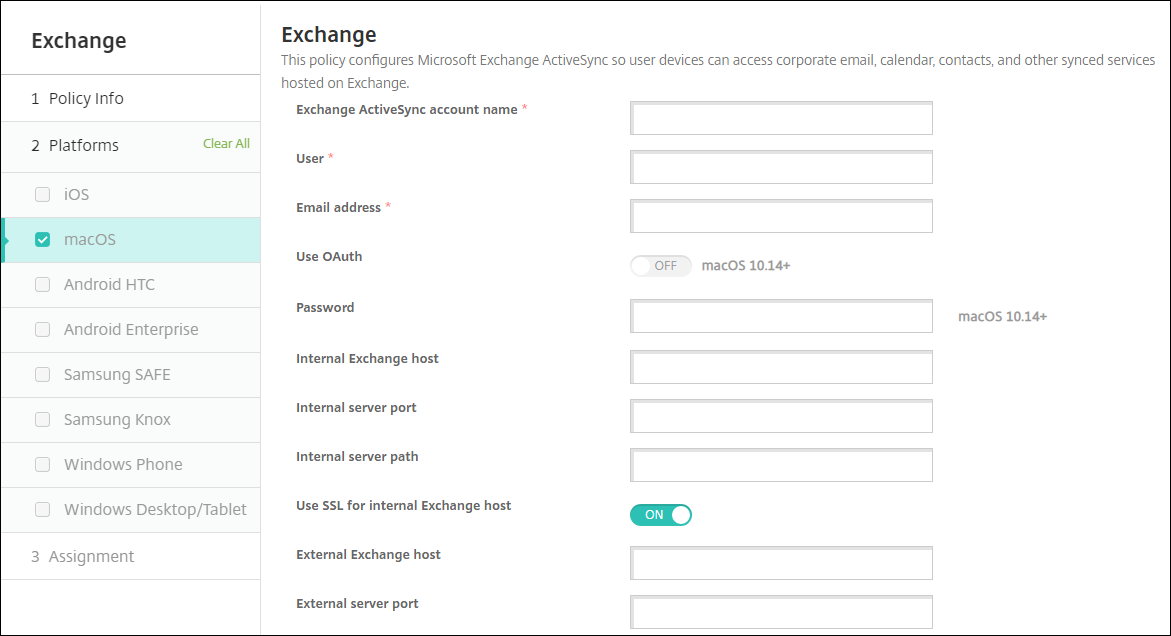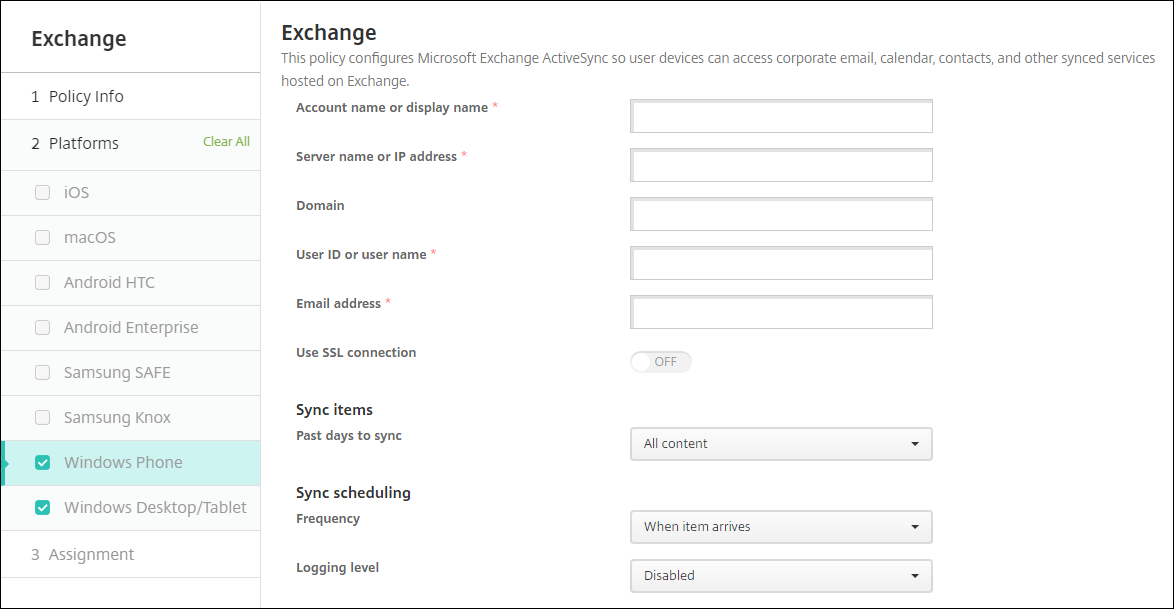Exchange device policy
You can use the Exchange ActiveSync device policy to configure an email client on user devices to let them access their corporate email hosted on Exchange. Each platform requires a different set of values, which are described in detail in the following sections.
To create this policy, you need the host name or IP address of the Exchange Server. For information about ActiveSync settings, see the Microsoft article, ActiveSync CSP.
To add or configure this policy, go to Configure > Device Policies. For more information, see Device policies.
iOS settings

- Exchange ActiveSync account name: Type the description of the email account that is displayed on user devices.
- Exchange ActiveSync host name: Type the address of the email server.
- Use SSL: Select whether to secure connections between user devices and the Exchange Server. The default is On.
-
Domain: Enter the domain in which the Exchange Server is. You can use the system macro
$user.domainnamein this field to automatically lookup user domain names. -
User: Specify the user name for the Exchange user account. You can use the system macro
$user.usernamein this field to automatically lookup user names. -
Email address: Specify the full email address. You can use the system macro
$user.mailin this field to automatically lookup user email accounts. - Use OAuth: If set to On, the connection uses OAuth for authentication. The default is Off. This option applies to iOS 12.0 and later.
- Password: Enter an optional password for the Exchange user account. This setting doesn’t appear when Use OAuth is On.
- Email sync interval: In the list, choose how often the email is synced with the Exchange Server. The default is 3 days.
- Identity credential (keystore or PKI): Click an optional identity credential in the drop-down list if you’ve configured an identity provider for Citrix Endpoint Management. This field is only required when Exchange requires a client certificate authentication. The default is None.
-
Authorize moving email between accounts: Select whether to allow users to:
- move email out of this account into another account
- forward email from a different account
- reply from a different account.
The default is Off.
- Send email only from the email app: Select whether to restrict users to the iOS mail app for sending email. The default is Off.
- Prevent users from syncing recent addresses: Select whether to prevent users from syncing recent addresses. The default is Off.
- Allow Mail Drop: Select whether to allow the account to use Mail Drop. The default is Off.
-
Enable S/MIME signing: Select whether this account supports S/MIME signing. The default is On. When set to On, the following fields appear.
- Signing identity credential: Choose the signing credential to use.
- User can override S/MIME signing: If set to On, users can turn S/MIME signing on and off in the settings of their devices. The default is Off. This option applies to iOS 12.0 and later.
- User can override S/MIME signing certificate UUID: If set to On, users can select, in the settings of their devices, the signing credential to use. The default is Off. This option applies to iOS 12.0 and later.
-
Enable S/MIME encryption: Select whether this account supports S/MIME encryption. The default is Off. When set to On, the following fields appear.
- Encryption identity credential: Choose the encryption credential to use.
- Enable per message S/MIME switch: When set to On, shows users an option to switch S/MIME encryption on or off for each message they compose. The default is Off.
- User can override S/MIME encryption: If set to On, users can, in the settings of their devices, select whether S/MIME is on by default. The default is Off. This option applies to iOS 12.0 and later.
- User can override S/MIME encryption certificate UUID: If set to On, users can turn S/MIME encryption identity and encryption on and off in the settings of their devices. The default is Off. This option applies to iOS 12.0 and later.
-
Policy settings
-
Remove policy: Choose a method for scheduling policy removal. Available options are Select date and Duration until removal (in hours)
- Select date: Click the calendar to select the specific date for removal.
- Duration until removal (in hours): Type a number, in hours, until policy removal occurs.
-
Remove policy: Choose a method for scheduling policy removal. Available options are Select date and Duration until removal (in hours)
Synced Exchange Services
The synced Exchange Services settings allow you to choose whether to sync the following features:
- Calendars
- Contacts
- Notes
- Reminders
macOS settings

- Exchange ActiveSync account name: Type the description of the email account that is displayed on user devices.
-
User: Specify the user name for the Exchange user account. You can use the system macro
$user.usernamein this field to automatically lookup user names. -
Email address: Specify the full email address. You can use the system macro
$user.mailin this field to automatically lookup user email accounts. - Use OAuth: If set to On, the connection uses OAuth for authentication. The default is Off. This option applies to macOS 10.14 and later.
- OAuth sign-in URL: Specifies the URL to load into a webview to authenticate using OAuth when you don’t use the AutoDiscovery service. This field appears when Use OAuth is set to On.
- Password: Enter an optional password for the Exchange user account. This setting doesn’t appear when Use OAuth is On.
- Internal Exchange host: If you want your internal and external Exchange host names to be different, type an optional internal Exchange host name.
- Internal server port: If you want your internal and external Exchange server ports to be different, type an optional internal Exchange server port number.
- Internal server path: If you want your internal and external Exchange server paths to be different, type an optional internal Exchange server path.
- Use SSL for internal Exchange host: Select whether to secure connections between user devices and the internal Exchange host. The default is On.
- External Exchange host: If you want your internal and external Exchange host names to be different, type an optional external Exchange host name.
- External server port: If you want your internal and external Exchange server ports to be different, type an optional external Exchange server port number.
- External server path: If you want your internal and external Exchange server paths to be different, type an optional external Exchange server path.
- Use SSL for external Exchange host: Select whether to secure connections between user devices and the internal Exchange host. The default is On.
-
Allow Mail Drop: Select whether to allow users to share files wirelessly between two Macs, without having to connect to an existing network. The default is Off.
-
Policy settings
-
Remove policy: Choose a method for scheduling policy removal. Available options are Select date and Duration until removal (in hours)
- Select date: Click the calendar to select the specific date for removal.
- Duration until removal (in hours): Type a number, in hours, until policy removal occurs.
- Allow user to remove policy: You can select when users can remove the policy from their device. Select Always, Passcode required, or Never from the menu. If you select Passcode required, type a passcode in the Removal passcode field.
- Profile scope: Select whether this policy applies to a User or an entire System. The default is User. This option is available only on macOS 10.7 and later.
-
Remove policy: Choose a method for scheduling policy removal. Available options are Select date and Duration until removal (in hours)
Windows Desktop/Tablet settings

Note:
This policy does not allow you to set the user password. Users must set that parameter from their devices after you push the policy.
- Account name or display name: Type the Exchange ActiveSync account name.
- Server name or IP address: Type the Exchange Server host name or IP address.
-
Domain: Enter the domain in which the Exchange Server is. You can use the system macro
$user.domainnamein this field to automatically lookup user domain names. -
User ID or user name: Specify the user name for the Exchange user account. You can use the system macro
$user.usernamein this field to automatically lookup user names. -
Email address: Specify the full email address. You can use the system macro
$user.mailin this field to automatically lookup user email accounts. - Use SSL connection: Select whether to secure connections between user devices and the Exchange Server. The default is Off.
- Past days to sync: In the list, click how many days into the past to sync all content on the device with the Exchange Server. The default is All content.
- Frequency: Click the schedule in the drop-down list that you want to use when syncing data that is sent to the device from the Exchange Server. The default is When item arrives.
- Logging level: Click Disabled, Basic, or Advanced in the drop-down list to specify the level of detail when logging Exchange activity. The default is Disabled.